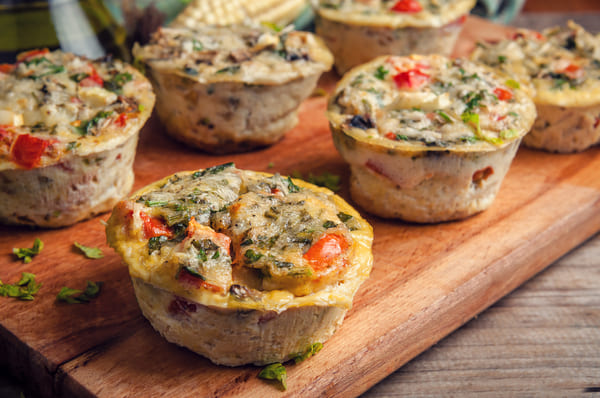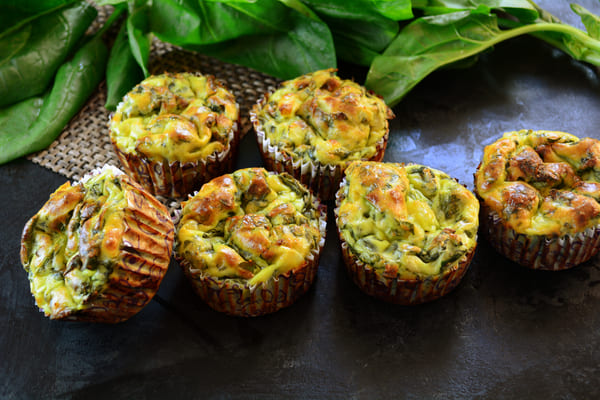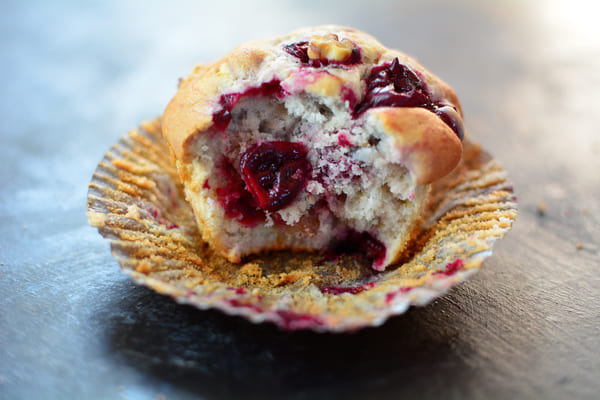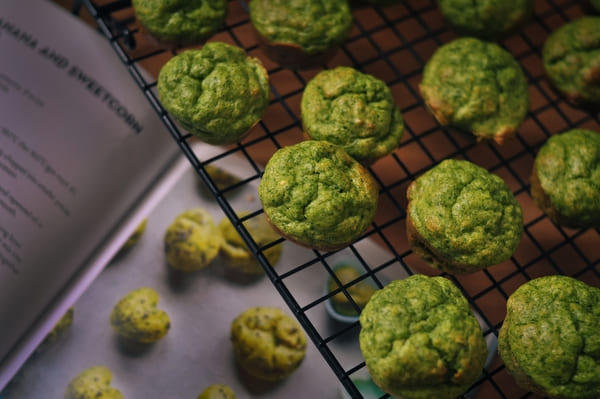Explore the Benefits of Protein Muffins, Get DIY Recipes, and Learn How to Effectively Incorporate them Into Your Diet.
Are Protein Muffins Suitable for Weight Loss?
🧁 Adding protein muffins to your weight loss program can help you feel fuller, thanks to their high protein content. Maintaining awareness of the total amount of calories you consume and ensuring you obtain a diverse range of nutritious calories is essential.
Protein muffins are becoming increasingly popular among people trying to lose weight. When you look them up online, there are many resources, recipes, and choices. You may learn more about protein muffins here if you’re wondering if they may help in weight loss.
This blog post aims to give you a complete understanding of protein muffins. We will discuss their health advantages, present you with different recipe choices that can be conveniently made at home, and assess their efficacy in aiding weight loss. In addition, we will also examine protein muffins that are available for purchase at stores. We’re going to also talk about some additional treats or snacks that are high in protein and that you can include in your diet.

Table of Contents
- Why the Fascination with Protein Muffins?
- Why are Protein Muffins Good?
- DIY Protein Muffin Recipes
- Variety of Protein Muffins Recipe
- Evaluating the Effectiveness of Protein Muffins for Weight Loss
- Store-Bought Protein Muffins and Alternatives
- Frequently Asked Questions
- Final thoughts
Why the Fascination with Protein Muffins?
They offer a convenient and delicious way to increase your protein intake. Protein plays a crucial role in various bodily functions such as metabolism, feeling satisfied after meals, and repairing and building muscles. By incorporating protein-rich muffins into your diet, you can potentially support your weight loss journey while enjoying a satisfying treat.

We acknowledge that baking muffins may not be feasible for everyone. Therefore, we will investigate pre-made alternatives for protein muffins and showcase additional protein-rich bakery items or snacks that are readily available in stores.
This blog post might be helpful whether you want to learn how to make your own protein muffins or you want suggestions on which bought from stores ones to choose from. We’ll explore the truth about protein muffins and how they can affect your weight loss journey. Read on!
Why are Protein Muffins Good?

Protein muffins have garnered attention in the health and fitness community for good reason. Protein muffins can be a wise choice for weight loss or a healthy lifestyle. They offer numerous benefits, which we will explore further:
Satiety and Hunger Control
Protein muffins have the primary benefit of increasing feelings of fullness and keeping hunger at bay. Compared to carbs or fats, protein has a higher satiety factor. By incorporating protein muffins into your meal plan or snacking routine, you can extend feelings of fullness, which may help prevent overeating or giving in to junk food cravings.
Muscle Repair and Maintenance
To maintain and repair muscles, protein is essential. During a weight loss program, preserving lean muscle mass is crucial while losing excess body fat. Eating protein muffins is a great way to add more protein to your diet easily. This will help support your muscles by providing the nutrients they need to grow and recover.
Metabolism Boost
Eating meals that contain protein, like muffins, can help increase your metabolism by increasing the amount of calories your body burns during digestion and absorption. This is because protein has a higher thermic effect than carbohydrates and fats. This slight boost can potentially aid in your weight loss efforts.
Nutrient Density
Protein muffins can be a nutrient-dense alternative to traditional baked goods. The recipe includes healthy ingredients like whole grains, nuts, seeds, and fruits. This nutrient density ensures that you’re satisfying your taste buds and nourishing your body with valuable nutrients.
Convenience and Portability
Protein muffins are a convenient dietary option for people who have a busy lifestyle. An excellent option for a quick and portable snack if you’re always on the go, whether it’s for work or the gym, protein muffins can be a great alternative. You can prepare them beforehand and enjoy them wherever you are.
Versatile Flavor Options
Protein muffins are available in a range of flavors, including classic options like chocolate and blueberry and more unique combinations like peanut butter and banana or carrot cake. This variety of flavors means you can find a protein muffin recipe that fits your tastes, making it easier to maintain healthy eating habits.
DIY Protein Muffin Recipes

This recipe is good for you if you’re following a ketogenic diet and want protein muffins that meet your dietary needs. The muffins will provide a satiating effect due to their rich protein content, beneficial fats, and low carbohydrate content, helping you feel satisfied and full for a more extended period. Let’s explore the components and procedures in more detail:
Ingredients
- 1 cup almond flour
- 1/4 cup coconut flour
- 1/4 cup whey protein powder muffins (unsweetened and low-carb)
- 1/4 cup erythritol or preferred keto-friendly sweetener
- 1 teaspoon baking powder
- 1/4 teaspoon salt
- 4 large eggs
- 1/4 cup of almond milk without sugar
- 1/4 cup melted coconut oil
- 1 teaspoon vanilla extract or vanilla protein powder
- Optional: 1/4 cup sugar-free chocolate chips or chopped nuts for toppings
Process
- Set a muffin tin to baking at 350°F (175°C) and grease or line the cups.
- In another serving, combine the eggs, almond milk, melted coconut oil, and vanilla extract and whisk until well combined.
- Gradually add the wet ingredients to the dry ingredients, stirring until a thick batter forms. Ensure there are no lumps.
- It’s important that you split the batter equally and fill each muffin cup to about 3/4 of the way. Add chopped nuts or sugar-free chocolate chips as preferred.
- Bake the muffins for 18 to 20 minutes or until they are brown. Once a toothpick inserted into the center of the muffins is clean, they are fully cooked.
Nutritional Value (per serving, yields 12 muffins)
- Calories: Approximately 140
- Fat: 11g
- Protein: 6g
- 4 grams of carbohydrates (net: 2 grams)
- Fiber: 2g
These delicious and healthy homemade protein muffins are perfect for anyone following a ketogenic diet. Because they are rich in protein and fat and low in carbohydrates, they make a great filling snack or quick breakfast.
Remember that controlling your portions is crucial, particularly with treats suitable for the keto diet. To achieve your goals while consuming these muffins as a part of a ketogenic diet, be careful to measure your macronutrients and calories.
Variety of Protein Muffins
There are many varieties of protein muffins to try, so you can keep your taste buds happy and accommodate different preferences. Here are some options.
Peanut Butter Chocolate Chip
Add a tablespoon of peanut butter and several sugar-free chocolate chips into your muffin batter to make a wonderful muffin with peanut butter and chocolate flavors or chocolate protein powder.
Cinnamon Roll
Mix in cinnamon and a cream cheese swirl to make your muffins more flavorful and fragrant. For an added hint of sweetness, sprinkle cinnamon sugar on top.
Lemon Poppy Seed
These muffins are great for anyone who loves citrus flavors. To give them a fresh taste, mix in poppy seeds and add both the zest and juice of a lemon to the batter.
Matcha Green Tea
Consider adding matcha green tea powder to the batter to give your muffins a unique twist. This will infuse your muffins with a beautiful green color and a delicate earthy taste.
Berry Burst
Add fresh or frozen berries like blueberries, raspberries, and strawberries to the muffin batter for a delicious treat packed with antioxidants and natural sweetness.

Pumpkin Spice
Embrace the flavors of fall with a pumpkin spice protein muffin. Add pumpkin puree, spices, nutmeg, cinnamon, and cloves for a warm and comforting treat.
Almond Joy
You can copy the flavor of an Almond Joy candy bar by combining finely chopped almonds, unsweetened coconut flakes, and sugar-free chocolate chips. It’s a tempting approach to indulge your taste buds.
Banana Nut
For a protein muffin that tastes like banana nut bread, you can mash ripe bananas into your batter and fold in some chopped walnuts.
Chai Spice
Add cinnamon, ginger, cardamom, and cloves to your muffin batter for a delicious spiced chai latte flavor experience.
Apple Cinnamon
Add grated apples and a dash of cinnamon to your muffin batter for a delicious and aromatic treat. This will give your muffins a moist texture and a delightful flavor.
Evaluating the Effectiveness of Protein Muffins for Weight Loss

Protein muffins are becoming popular for weight loss due to their high protein content that keeps you full and nutrient-packed ingredients. It is essential to consider whether relying solely on protein muffins can lead to successful weight loss.
Remember that just eating protein muffins may not necessarily result in weight loss. While beneficial for weight loss, monitor calorie intake, maintain a balanced macronutrient ratio, and exercise regularly. Remember these essential elements:
Caloric Intake: To lose weight, consuming fewer calories than you burn is crucial, creating a calorie deficit. While protein muffins can fit into a diet with a calorie limit, monitoring how many calories you consume every day is crucial. Avoid going overboard with your calorie intake or exceeding your daily limit while having a protein muffin.
Macronutrient Balance: Aside from caloric intake, how much of the macronutrients protein, carbs, and fats are essential for weight loss Protein muffins can contribute to meeting your protein requirements, which aids in muscle maintenance and helps keep you feeling full. However, it’s essential to also prioritize a balance of healthy fats, complex carbohydrates, and a variety of vegetables in your overall diet.
Exercise and Physical Activity: Regular physical activity is key to any weight loss journey. While protein muffins can provide energy and support muscle recovery, they should be accompanied by a well-rounded exercise routine. Combining cardiovascular exercises and strength training can enhance your weight loss efforts and overall health.
Overall Dietary Balance: It’s crucial to view protein muffins as part of a balanced diet rather than relying solely on them for weight loss. Your diet should contain lean proteins, fresh produce, entire grains, and healthy fats. Protein muffins can be an enjoyable and valuable means to add more protein to your diet, but they shouldn’t take the place of a balanced diet.
Store-Bought Protein Muffins and Alternatives

For those who prefer convenience or may not have the time to bake their own protein muffins, store-bought options are readily available in the market. Let’s explore some famous brands and their nutritional profiles. However, it’s important to note that nutritional information may vary between different flavors and product lines within each brand.
Quest Nutrition Protein Muffins
Nutritional Profile (per muffin):
- Calories: Approximately 110-130
- Protein: 12-15g
- Fat: 5-7g
- Net Carbs: 2-4g
- Fiber: 1-4g
- Sugar: 0-2g
Pros: Low in sugar, high in protein, and provided in a variety of flavors.
Cons: Some flavors may contain artificial sweeteners or sugar alcohols, which may not be suitable for everyone.
Lenny & Larry’s The Complete Cookie
Nutritional Profile (per cookie):
- Calories: Approximately 180-210
- Protein: 8-16g
- Fat: 4-10g
- Net Carbs: 19–30g
- Fiber: 2-6g
- Sugar: 3-11g
Pros: Vegan options are available, high in fiber, and a range of flavors.
Cons: Higher in calories and carbohydrates compared to some other options, may contain added sugars.
One Protein Bars
Nutritional Profile (per bar)
- Calories: Approximately 200-230
- Protein: 20-22g
- Fat: 7-9g
- Net Carbs: 3–9g
- Fiber: 8-10g
- Sugar: 1-3g
Pros: Low in sugar, high in protein, and provided in a variety of tastes.
Cons: Some flavors may contain sugar alcohols, which can cause digestive issues for some individuals.
FitJoy Protein Bars
Nutritional Profile (per bar):
- Calories: Approximately 210-230
- Protein: 20-22g
- Fat: 10-12g
- Net Carbs: 11–15g
- Fiber: 11-13g
- Sugar: 3-4g
Pros: High protein content, low sugar, and gluten-free options available.
Cons: Higher in calories and carbohydrates compared to some other options.
Pros and Cons of Store-Bought Options
Pros:
- Convenience: Store-bought protein muffins and snacks offer a quick and hassle-free option for those with busy lifestyles or limited baking skills.
- Portion Control: Individually wrapped products provide portion-controlled servings, making it easier to manage calorie intake.
- Variety: Store-bought options offer a wide range of flavors and brands to choose from, catering to different preferences.
Cons:
- Ingredients and Additives: Some store-bought options may contain added sugars, artificial sweeteners, or other additives that may not align with specific dietary preferences or sensitivities.
- Cost: Store-bought protein muffins and snacks can be more expensive than homemade alternatives.
- Nutritional Variations: Nutritional profiles can vary between brands and flavors, so reading labels and choosing options that fit your specific dietary goals and preferences is essential.
It ultimately depends on your personal preferences, dietary requirements, and lifestyle when deciding whether to choose pre-made protein muffins from a store or make your own at home. If you prioritize convenience, store-bought options can be a good choice.
However, make sure to carefully check the ingredient list and nutritional information. On the other hand, making your own protein muffins gives you greater control over the ingredients used and allows for more customization options.
Make sure to consider your overall nutritional requirements, such as the balance of macronutrients and calorie intake, when adding store-bought or homemade protein muffins to your weight loss regimen.
Frequently Asked Questions
Can I Replace a Meal with a Protein Muffin?
While protein muffins can be a nutritious and filling snack, replacing a complete meal with just a protein muffin is generally not recommended. While protein muffins can provide a good amount of protein, they may lack other essential nutrients that a balanced meal typically provides.
A meal should contain a mix of fruits and vegetables, lean proteins, healthy fats, complex carbohydrates, and other food groups to be called well-rounded. These components offer a more significant number of fiber, vitamins, and minerals that are crucial for overall health and the practical function of the body.
Protein muffins boost protein intake and make a nutritious meal or snack, but remember to incorporate them into a balanced diet. If you plan to replace a meal with a protein muffin, it’s essential to ensure that you meet your nutritional requirements by incorporating other meals that are rich in essential nutrients.

There are carefully produced meal replacement shakes or bars that are made to deliver a balance of macronutrients and essential vitamins and minerals if you’re seeking a meal replacement solution. These options tend to be more comprehensive regarding meeting nutritional requirements than a single-protein muffin.
Can I Freeze Protein Muffins?
Yes, you can absolutely freeze protein muffins to extend their shelf life. Freezing protein muffins is a convenient way to preserve them and enjoy them at a later time. Here’s how you can freeze protein muffins:
- Allow the muffins to cool completely: Let the protein muffins cool down at room temperature before preparing them for freezing. This helps prevent condensation and ice crystals from forming inside the packaging.
- Wrap individually or use airtight containers: Wrap each protein muffin individually in plastic wrap or place them in airtight containers. Alternatively, you can use resealable freezer bags. The goal is to create a barrier that prevents freezer burn and helps maintain the muffins’ freshness.
- Label and Date: Label the packaging with the date to track when the protein muffins were frozen. This will help you consume them within a reasonable timeframe and maintain quality.
- Place in the freezer: Put the wrapped or packaged protein muffins in the freezer. Ensure they are stored in a flat position to maintain their shape.
- Thawing and reheating: Thaw the frozen protein muffin in the fridge or at room temperature. Warm the muffin in the microwave for a short duration or bake it in the oven for a more extended period before savoring its deliciousness.
Properly stored and frozen, protein muffins typically last about 2-3 months. However, consuming them within the first month of freezing is recommended for the best quality and taste.
Freezing protein muffins can be especially beneficial if you have made a large batch or want to prepare them in advance for busy days. It allows you to have a quick and nutritious snack or breakfast option available whenever needed.
Are Protein Muffins Suitable for Vegetarians or Vegans?
Protein muffins can work well for both vegetarians and vegans as long as the recipe or store-bought options are chosen with suitable ingredients. Here’s what to consider:
- Vegetarian Protein Muffins: Vegetarian protein muffins are made without any meat or fish ingredients. Protein muffins often contain dairy products like (milk, yogurt, or cheese) and plant-based protein sources (beans, nuts, seeds, lentils). These muffins can provide a good amount of protein while still aligning with a vegetarian diet.
- Vegan Protein Muffins: The only ingredients in vegan protein muffins are plants; no animal products are used. They exclude ingredients such as eggs, dairy, and honey. Instead, they use vegan-friendly sweeteners, almond or coconut milk, protein powders made from pea or soy, and legume flours as sources of plant-based protein.
When following a vegetarian or vegan diet, it’s essential to read the ingredients carefully, whether preparing protein muffins at home or choosing store-bought options. Some protein muffins could include ingredients like eggs or whey protein, a dairy byproduct that is not good for vegans but might be acceptable for vegetarians.

If you are confused about whether a protein muffin is vegetarian or vegan, it is recommended to check the recipe or product label or ask the maker for clarification.
As vegan diets gain popularity, an increasing number of dishes and prepared foods are now tailored to meet these dietary preferences. This includes a wide variety of vegetarian or vegan protein muffins, allowing individuals to enjoy a tasty and protein-packed snack while staying true to their dietary choices.
How do Protein Muffins Compare to Other High-Protein Snacks?
How do protein muffins stack up against other high-protein snacks? Protein muffins provide a delightful and practical method to add protein to your diet. Let’s explore their advantages and considerations in comparison to other popular high-protein snacks:
Protein Bars: Protein bars are a common choice for those seeking a quick and portable high-protein snack. Depending on the brand and flavor, they typically have a concentrated protein content of 10 to 30 grams per bar. Protein bars are available in various flavors and are generally formulated to be convenient for on-the-go consumption. Also, read the ingredient list carefully, as some protein bars could have extra sugar, artificial sweeteners, or other ingredients.
Greek Yogurt: For those who like a creamy and tangy delight, Greek yogurt is a great high-protein snack option. It typically contains around 15-20 grams of protein per serving. Greek yogurt also offers the added benefit of probiotics, which support gut health. Opt for plain or unsweetened varieties to avoid added sugars, and consider adding fruits or nuts for extra flavor and nutrients.
Hard-Boiled Eggs: Eggs are a natural and protein-packed snack. One large egg contains approximately 6 grams of protein, making it a convenient option to boost protein intake.
Nuts and Seeds: Because of the protein, fiber, and good fats that nuts and seeds contain, they make a tasty snack. Almonds, peanuts, cashews, chia seeds, and pumpkin seeds are all excellent choices for a nutritious diet. It’s essential to consume them in moderation as they are calorie-dense.
Cottage Cheese: Cottage cheese is another high-protein snack option, providing approximately 20 grams of protein per cup. It also contains a lot of calcium and could help with muscle healing. Consider adding fruits, vegetables, or herbs for added flavor and nutrients.
When comparing protein muffins to other high-protein snacks, it’s essential to consider factors such as taste preference, convenience, and overall nutritional profile. Protein muffins can offer a homemade option that allows for customization and a more comprehensive range of flavors compared to some pre-packaged snacks. However, it’s essential to be mindful of ingredients, portion sizes, and individual dietary needs when incorporating any high-protein snack into your diet.
When selecting high-protein snacks, consider your dietary goals, macronutrient balance, and personal preferences to find the best options for you.
How Can I Make Protein Muffins Suitable for a Gluten-Free Diet?
To make protein muffins gluten-free, use alternative flour and naturally gluten-free ingredients.
Here are some tips for creating delicious gluten-free protein muffins:
- Use Gluten-Free Flours: Replace regular wheat flour with gluten-free flour alternatives. You can choose from popular options like almond flour, coconut flour, oat flour (make sure it’s certified gluten-free), rice flour, or a gluten-free flour blend to make protein muffins suitable for a gluten-free diet. These flours provide structure and texture to your muffins while keeping them gluten-free.
- Add Binders and Moisture: Gluten-free flour alternatives tend to have a drier and more crumbly texture than wheat flour. To enhance the texture and moisture in your muffins, consider adding ingredients like mashed bananas, unsweetened applesauce, or Greek yogurt. These ingredients provide moisture and contribute to the overall flavor profile.
- Xanthan Gum or Psyllium Husk: To improve gluten-free muffins’ texture and binding properties, you can add a small amount of Xanthan gum or psyllium husk powder. These ingredients help mimic the elasticity and structure usually provided by gluten in wheat-based baked goods. Follow the recommended amounts on the package instructions for best results.
When preparing gluten-free protein muffins, check for gluten-free labeling on all ingredients used, including baking powder, baking soda, and any additional mix-ins. Cross-contamination can occur during processing, so choosing products labeled explicitly gluten-free is essential.

When making gluten-free muffins, be mindful of cross-contamination and take necessary precautions. Use clean utensils, mixing bowls, and baking pans that have not come into contact with gluten-containing ingredients. Also, avoid contamination by using separate baking liners or greasing the muffin tin.
Test and Adjust: Gluten-free baking can be a bit tricky due to the absence of gluten, which provides structure and elasticity. Be prepared for some experimentation to achieve the desired texture and taste. You may need to adjust the amount of liquid, flour, or binding agents in the recipe to get the best results.
How do you Store Protein Muffins?
Guidelines for storing protein muffins and keeping them fresh:
- Allow Muffins to Cool: Before storing the protein muffins, make sure they have completely cooled down. Placing warm muffins in a storage container or wrapping them can create condensation, leading to moisture buildup and potentially making the muffins soggy.
- Store in an Airtight Container: Transfer the cooled protein muffins to an airtight container. A container with a tight seal helps prevent air exposure and moisture loss, keeping the muffins fresh for longer.
- Line the Container: If desired, line the container with parchment paper or muffin liners to create a barrier between the muffins and the container. This can help maintain their shape and prevent sticking.
- Refrigerate for Short-Term Storage: If you plan to consume the protein muffins within a few days, storing them in the refrigerator is a good option. Please store the container in the refrigerator to keep the muffins fresh and maintain their texture. Refrigerated protein muffins can last approximately 3-4 days if stored properly.
- To store protein muffins for a more extended period, you can freeze them. Wrap each muffin separately in plastic wrap or use freezer-safe bags. To prevent freezer burn, make sure to seal the protein muffins tightly. Typically, frozen protein muffins can remain suitable for 2-3 months.
- Thawing Frozen Muffins: When ready to enjoy a frozen protein muffin, remove it from the freezer and let it thaw at room temperature or microwave it for a short duration on a low setting. This will help restore its texture and freshness.
Final Thoughts
In conclusion, protein muffins can be a valuable addition to a weight loss diet when approached with the right mindset and considerations. Throughout this blog post, we explored protein muffins’ popularity and potential benefits for weight loss and provided a recipe guide for homemade options.
We discussed the importance of portion control and moderation when consuming protein muffins, as they should be viewed as part of a balanced eating plan rather than a standalone solution for weight loss. While protein muffins can be a convenient and tasty way to increase protein intake, it’s crucial to consider overall calorie intake, macronutrient balance, and regular exercise to achieve weight loss goals effectively.
We also highlighted the availability of store-bought protein muffins and alternatives, offering a list of famous brands and their nutritional profiles. While store-bought options can provide convenience, it’s essential to carefully read labels and be aware of added sugars, artificial additives, and potential allergens.
Throughout the discussion, we emphasized the need for individual customization and encouraged readers to experiment with homemade protein muffin recipes to suit their taste preferences and dietary needs. However, we emphasized the importance of consulting with a healthcare professional or registered dietitian to receive personalized advice based on individual health and nutritional requirements.

Remember, protein muffins can be a delicious and nutritious snack or part of a meal, but they are just one component of a comprehensive weight loss plan. By approaching protein muffins as part of a balanced diet, being mindful of portion sizes, and seeking professional guidance, individuals can make informed decisions that align with their weight loss goals and overall well-being.

